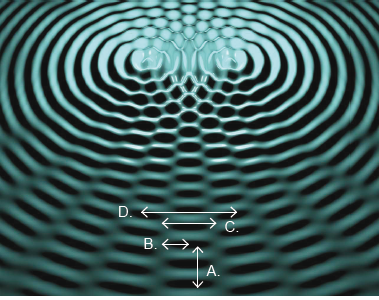Question
A group of students perform an experiment to find the refractive index of a glass block. They measure various values of the angle of incidence \(i\) and angle of refraction \(r\) for a ray entering the glass from air. They plot a graph of the \(\sin r\) against \(\sin i\).

They determine the gradient of the graph to be \(m\).
Which of the following gives the critical angle of the glass?
A. \(\sin ^{-1}(m)\)
B. \(\sin ^{-1}\left(\frac{1}{m}\right)\)
C. \(m\)
D. \(\frac{1}{m}\)
▶️Answer/Explanation
Ans:A

\(\begin{aligned} \quad & n_1 \text { sin i }=n_2 \sin r \\ & \text { Snalls Law. } \\ m(slope) = & \frac{\sin r}{\sin i}=\frac{n_1}{n_2}=\frac{1}{n}\end{aligned}\)
$n_1=1$ and $n_2 =n$
Now , TIR comes to action from which we have to calculate the critical angle (and happens only when ray goes from denser to rarer medium)

\(\begin{aligned}
& n \cdot \sin \theta_c=1 \cdot \sin 90 \\
& n \cdot \sin \theta_c=1 \Rightarrow \theta_c=\sin ^{-1}\left(\frac{1}{n}\right)\\
&\theta_c=sin ^{-1} m
\end{aligned}\)
Question
Two identical sources oscillate in phase and produce constructive interference at a point \(P\). The intensity recorded at \(\mathrm{P}\) is \(I\).
What is the intensity at \(P\) from one source?
A. \(\sqrt{2} I\)
B. \(I\)
C. \(\frac{I}{2}\)
D. \(\frac{I}{4}\)
▶️Answer/Explanation
Ans:D
When two identical sources oscillate in phase and produce constructive interference at a point, the resulting intensity at that point is four times the intensity from one of the sources.
So, the intensity at point P from one source is:D. \(\frac{I}{4}\)
Electromagnetic waves
A. always obey an inverse square law.
B. are made up of electric and magnetic fields of constant amplitude.
C. always travel at the same speed in a vacuum.
D. are always polarized.
Answer/Explanation
Markscheme
C
In physics, electromagnetic radiation consists of waves of the electromagnetic field, which propagate through space and carry electromagnetic radiant energy. It includes radio waves, microwaves, infrared, light, ultraviolet, X-rays, and gamma rays. All of these waves form part of the electromagnetic spectrum.

Electromagnetic radiation is a type of energy that is commonly known as light. Generally speaking, we say that light travels in waves, and all electromagnetic radiation travels at the same speed which is about \(3.0\times 10^{-8}\) meters per second through a vacuum.
Waves emitted from sources X and Y have equal wavelengths and are initially in phase. The waves interfere destructively at point P, where the path difference is 0.60m.

What is a possible value for the wavelength of the waves?
A. 0.20 m
B. 0.30 m
C. 0.40 m
D. 0.60 m
Answer/Explanation
Markscheme
C
For destructive interference,
Path difference\(=(2n+1)\frac{\lambda}{2}\)
\(0.6=(2n+1)\frac{\lambda}{2}\)
for possible values of \( \lambda\) we have check for different values of n.
For , n=0
\(0.6=\frac{\lambda}{2}\)
\(\lambda=1.2 \) not in gievn option
For n=1
\(0.6=(2\times1+1)\frac{\lambda}{2}\)
\(\lambda=0.4\) option-B
Question
The diagram shows an interference pattern produced by two sources that oscillate on the surface of a liquid.

Which of the distances shown in the diagram corresponds to one fringe width of the interference pattern?
Answer/Explanation
Markscheme
C
Fringe width is the distance between two consecutive bright spots (maximas, where constructive interference take place) or two consecutive dark spots (minimas, where destructive interference take place).